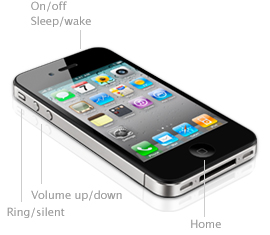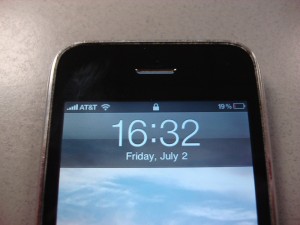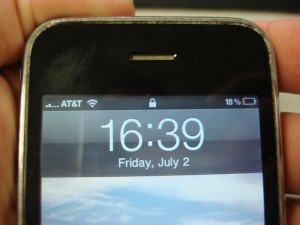Activism > Consumer Defense | Effective Living > Technology > Apple > iPhone
 Summary. Apple recently made world news because the antenna array on their iPhone 4 was reportedly providing irregular signal reception when touched. Supposedly, consumers and journalists worldwide were astonished to learn that touching an antenna would reduce signal strength.
Summary. Apple recently made world news because the antenna array on their iPhone 4 was reportedly providing irregular signal reception when touched. Supposedly, consumers and journalists worldwide were astonished to learn that touching an antenna would reduce signal strength.
- Update: On Friday, 16 July 2010, about two weeks after we first published this story, Steve Jobs held a press conference about the iPhone 4 antenna reception that reiterated what we said here. Apple has now published a web page (more eloquent and concise than ours) that documents mobile phone reception problems as industry-wide and includes videos to demonstrate it.
Hoax Exposed. Part of the iPhone 4 signal reception story is simply a well coordinated misinformation campaign and hoax launched by Apple competitors and those unfamiliar with antenna technology. The other part of the story is simply based on general truths about how mobile technology works. In summary, the iPhone 4 signal issue is an unfounded hoax, and so are the recent frivolous threats of class action lawsuits against Apple regarding the iPhone 4. This is all explained below.
Antenna History. Since the invention of the first radio devices in the late 1800s, it’s been common knowledge that the antenna of a radio receiver or transmitter should not be touched because this can interfere with reception and transmission. This knowledge was broadly disseminated worldwide during the forty years from 1970 to 2010 for anyone using CB radios, cordless phones, walkie talkies, handheld radios, televisions, and cellular phones. Anyone using an AM or FM radio knows the importance of antenna adjustment. Even walking near a radio can result in a faded signal. Television antennas known as “rabbit ears” and external array antennas were common for many decades in the late 20th century and continued to be in use early in the 21st century. For this reason, consumers became very aware of the importance of antenna positioning, direction, and placement. Antennas are designed to be a fraction (usually) of the wave they are receiving. Outside roof-top television antennas offer a visual image of varying antenna lengths corresponding with the wavelength of the frequencies they are designed to receive. Since the 1970s, consumers would purchase equipment from Radio Shack used to “Tune” CB antennas. Tuning a CB antenna is the process of lengthening or shortening it so that it’s length is optimally suited for channel 18 (a midway frequency in CB Radio broadcast and reception).
Signal Measurement. Because mobile phones and devices are transceivers (they receive and transmit), there are four considerations with signal measurement: incoming signal strength, incoming signal quality, outgoing signal strength, and outgoing signal quality. It is difficult to convey something as complex as the changing aggregate signal connection of a mobile device with only a 1 to 5 rating represented by some small bars. When any of these four properties are hindered (usually by obstructions), most devices attempt to boost transmission levels to compensate (which typically uses more battery). As the phone increases signal output, usually the connection (aggregate signal strength/quality) gets better. Signal strength is like volume is to music, whereas signal quality is how clear and accurate a signal is. Just as music can be loud but distorted, a radio signal can be strong, but have interference. Since mobile phone antenna towers are typically high in the air, interference is usually causes by obstructions in the proximity of the phone. Similarly, having sufficient signal strength from a mobile phone antenna tower is usually not a problem.
Exposed Metal Antenna Array Offers Breakthrough Design. Other than inexpensive walkie talkies with telescoping antennas, most portable transmitters and receivers have internal antennas or external extruding antennas with rubber or plastic insulation. The reason for this is to prevent direct conductive contact with the antenna. Here’s the trade-off: Internal antennas make sleek design possible yet have reduced performance, and external antennas get in the way yet can offer better reception and transmission by having a less obstructed antenna. According to technology specialist, Gregory Johnson, “The exposed metal antenna array on the Apple iPhone 4 is a breakthrough in advanced antenna design that can either be protected by a simple case, or enhanced by third party antenna boosters.”
Building a Safer Mobile Phone. With concerns about RF radiation back in the news (Time Magazine, 10 March 2010), people are looking for ways to reduce their RF exposure. Because of its external metal antenna array, the iPhone 4 potentially offers the potential for lower RF exposure. You might think that a bare antenna could have greater possible RF emissions. However, the opposite is true (when used properly). A bare antenna has greater reception and transmission potential which lowers the phone’s need to transmit at higher output levels. Because proximity interference is a known potential issue for all mobile phones, many people choose to use a bluetooth headset and keep their phone at a distance. This also reduces any possible adverse impact of exposure to RF radiation in two ways: (1) reduced proximity obstructions increases signal quality and strength which decreases the required intensity of transmission output, (2) strength of RF radiation intensity is reduced substantially at even a small increase in distance.
 Analysis and Commentary. Below is an analysis and commentary by Gregory Johnson.
Analysis and Commentary. Below is an analysis and commentary by Gregory Johnson.
“Having been granted a technician-class broadcasting license (N0YOD) from the Federal Communications Commission, I’m quite familiar with antenna technology. I grew up using AM, FM, CB, shortwave, and long-wave radio receivers and transmitters. So, I was immediately curious about Apple’s decision to place a metal, non-insulated multi-array antenna on the outside of their new iPhone 4.
After further research, I realized that the exposed metal antenna array on the Apple iPhone 4 is a breakthrough in advanced antenna design that can either be protected by a simple case, or effectively enhanced by third party antenna boosters — reducing battery drain. The problem with most antennas is that they are internal, or external but covered in plastic. The iPhone 4 antennas are conductively accessible, making it possible to connect a longer antenna of proper length for better reception or transmission. It probably won’t be long until companies offer cases with conductive contacts for antenna accessories that enhance the reception of the iPhone 4 beyond anything we’ve seen before. To be small enough for mobile devices, antennas are usually hindered and limited by smaller size. This isn’t the case with the iPhone 4 exposed antenna array.
Obviously, the conductivity of of the human hand on a bare antenna will vary depending on the person’s skin moisture and other factors, but it’s likely to influence reception and transmission. Any metal objects shorting between antennas could present a problem.
Radio transmitters are designed to have a specific antenna length. For example, owners of Citizen’s Band (CB) radios are advised not to use the radio until a properly tuned antenna is attached or else the radio may overheat and burn out. Most people know that an automatically extending radio antenna on a car will not receive FM radio properly until it has extended to the optimal length. As the antenna extends, reception gradually improves. The antenna length is set to be a fraction of the average wavelength for FM radio. These are things most people know intuitively through experience.
For these reasons, the colorful bumpers offered by Apple seemed to be more of a necessity than an optional accessory. Yet, such is the case with most electronic devices today for anyone wanting to protect them. This is probably why Apple doesn’t include them for free with the phone. Consumers will undoubtedly want to pick their own case, and Apple doesn’t want to cut into the sales of third party manufacturers who offer a wide variety of protective case options.
I was sure that other consumers and those in the press would have at least a basic knowledge of antenna technology, but apparently that wasn’t the case. Those predisposed to malign Apple’s reputation (competitors and haters) used this as an opportunity to launch a hoax on unsuspecting consumers and a smear campaign against Apple. The hoax aspect of this story is to suggest that reception problems are new, since reception issues have been present with every radio transmitter, receiver, and transceiver since the 1800s and this includes AM, FM, CB, Shortwave, Long-wave, television, and mobile phones.
The supposed reception issue with the iPhone 4 is nothing new. The 3GS and other mobile phones have similar variations in reception quality and signal strength depending on how they are held, as illustrated below.” ~ Gregory Johnson
Video Commentary. Below is a video commentary updated to include the latest news of the 16 July 2010 Apple press conference regarding the iPhone 4 antenna reception.
Apple iPhone 3GS Signal Strength Variations. Below are before and after photos illustrating variations in the iPhone 3GS signal reception as influenced by being held in the hand. These same results can be duplicated on numerous other mobile phone brands as demonstrated and documented by Apple on their mobile device consumer information and education page.


Statement from Apple Regarding iPhone 4 Reception. Below is the official statement from Apple, issued 2 July 2010, regarding the iPhone 4 reception issue. [source]
Letter from Apple Regarding iPhone 4
Dear iPhone 4 Users,
The iPhone 4 has been the most successful product launch in Apple’s history. It has been judged by reviewers around the world to be the best smartphone ever, and users have told us that they love it. So we were surprised when we read reports of reception problems, and we immediately began investigating them. Here is what we have learned.
To start with, gripping almost any mobile phone in certain ways will reduce its reception by 1 or more bars. This is true of iPhone 4, iPhone 3GS, as well as many Droid, Nokia and RIM phones. But some users have reported that iPhone 4 can drop 4 or 5 bars when tightly held in a way which covers the black strip in the lower left corner of the metal band. This is a far bigger drop than normal, and as a result some have accused the iPhone 4 of having a faulty antenna design.
At the same time, we continue to read articles and receive hundreds of emails from users saying that iPhone 4 reception is better than the iPhone 3GS. They are delighted. This matches our own experience and testing. What can explain all of this?
We have discovered the cause of this dramatic drop in bars, and it is both simple and surprising.
Upon investigation, we were stunned to find that the formula we use to calculate how many bars of signal strength to display is totally wrong. Our formula, in many instances, mistakenly displays 2 more bars than it should for a given signal strength. For example, we sometimes display 4 bars when we should be displaying as few as 2 bars. Users observing a drop of several bars when they grip their iPhone in a certain way are most likely in an area with very weak signal strength, but they don’t know it because we are erroneously displaying 4 or 5 bars. Their big drop in bars is because their high bars were never real in the first place.
To fix this, we are adopting AT&T’s recently recommended formula for calculating how many bars to display for a given signal strength. The real signal strength remains the same, but the iPhone’s bars will report it far more accurately, providing users a much better indication of the reception they will get in a given area. We are also making bars 1, 2 and 3 a bit taller so they will be easier to see.
We will issue a free software update within a few weeks that incorporates the corrected formula. Since this mistake has been present since the original iPhone, this software update will also be available for the iPhone 3GS and iPhone 3G.
We have gone back to our labs and retested everything, and the results are the same— the iPhone 4’s wireless performance is the best we have ever shipped. For the vast majority of users who have not been troubled by this issue, this software update will only make your bars more accurate. For those who have had concerns, we apologize for any anxiety we may have caused.
As a reminder, if you are not fully satisfied, you can return your undamaged iPhone to any Apple Retail Store or the online Apple Store within 30 days of purchase for a full refund.
We hope you love the iPhone 4 as much as we do.
Thank you for your patience and support.
Apple
Press Contacts:
Natalie Harrison
Apple
harri@apple.com
(408) 862-0565
Steve Dowling
Apple
dowling@apple.com
(408) 974-1896
* * *
Document History. This document was originally published on 2 July 2010. It was revised and republished on 20100708fr2140. This document was updated on 20100716fr to include news of the 16 July 2010 Apple press conference.